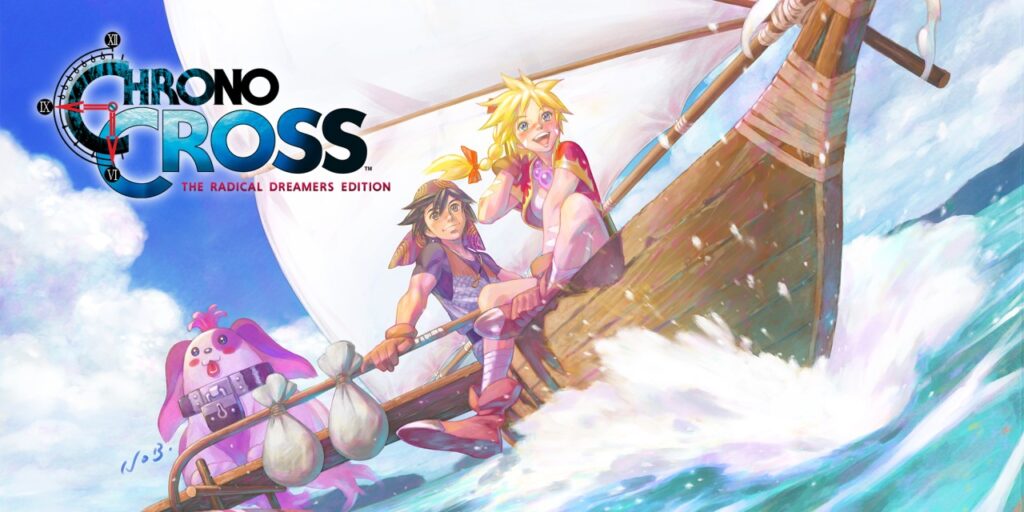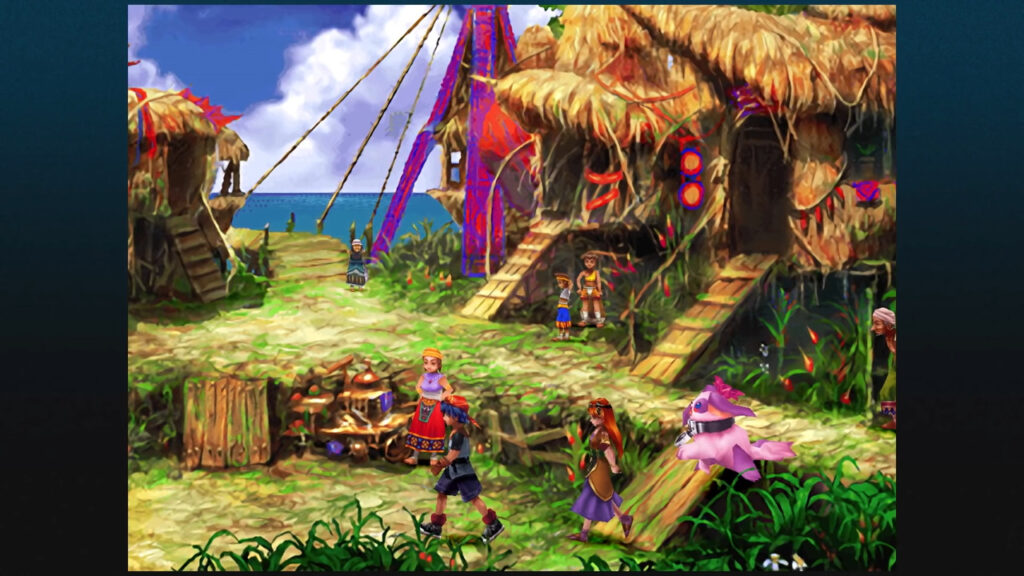
Developer: Square
Publisher: Square Enix
Platform: PC, Switch, PS4, Xbox One
Tested on: Switch
Chrono Cross: The Radical Dreamers Edition – Review
In what seems to be an ongoing effort to bring their entire back catalogue to modern consoles, Square Enix is back again with a re-release of an older title. This time, the honor goes to Chrono Cross, a sequel of sorts to Chrono Trigger. Arriving as the so-called Radical Dreamers Edition, this remastered version of the 1999 PlayStation title comes bundled with Radical Dreams, a text-based adventure for the Satellaview. Fans of the series will gobble this release up; if only to finally experience Radical Dreams for the first time. That being said, is this a title worth playing if you’re new to the Chrono series?
Story
While Chrono Trigger’s story was built around time travel, Chrono Cross takes things in a different direction and lets players travel between two alternate realities. Ten years prior to the events in Chrono Cross, the universe split in two. In one of these realities, protagonist Serge drowned, but in the other, he survived. When the surviving Serge ends up in the other reality, he teams up with a thief girl known as Kid, who possesses an amulet that allows the wearer to travel between the two realities. A series of events unfolds which see Serge ending up in another body and unable to travel between dimensions. In order to return to his original body, Serge must research the split that happened ten years ago. Now, we’re obviously not going to delve into spoiler territory too much here, as Chrono Cross is very much a story-driven experience, and is best experienced for yourself. Rest assured that you’ll find a gripping narrative filled with weird and wonderful characters, ranging from Poshul, a huge pink dog to Harle, a jester that suspiciously looks like a certain DC Comics character, although we’d chalk this one up to coincidence rather than intention.
Graphics
When you’re not remaking a game from the ground up but are remastering it, getting the visuals just right can be tricky. A lot has changed about the way displays work ever since Chrono Cross debuted back in 1999, and we’ve come a long way from the smaller CRT screens that the game was originally intended to be displayed on. Unfortunately, Chrono Cross’ graphics didn’t quite survive the transition to modern screens, likely because the upscaled image that we’re getting here is AI-generated, rather than cleaned up manually. This is an expensive process of course, so we understand the reasoning, but we do feel like this title deserves better. The difference is especially noticeable when comparing docked mode and handheld mode on Switch, with the latter providing an image that is noticeably nicer to look at, simply because the smaller screen hides some of the visual rough edges. On a larger screen, things tend to look blurry, as if vaseline was smeared over the screen. To make matters worse, the game also presents players with an incredibly choppy frame rate. The pre-rendered cutscenes are perhaps the final straw, as they look low-res and grainy.
It may sound like a contradiction, but the fact that the remaster of the visuals is so underwhelming actually highlights how good this game still looks twenty-two years later. It makes us long for what could have been, rather than the slapdash approach that we got now. This is mostly because of the excellent art direction. Nobuteru Yuki took over from Dragon Ball creator Akira Toriyama, and his designs for the characters and creatures that you’ll encounter here look more mature. The overall art style feels closer to the style we’ve come to associate with Square Enix’ franchises that aren’t Final Fantasy, but this shouldn’t be surprising as the designer was also responsible for Seiken Densetsu 3’s visuals. We can only imagine what could have been had Chrono Cross received the same treatment as the aforementioned title, as this led us to the fantastic Trials of Mana. Fortunately, if you wish to experience Chrono Cross’ visuals as they were intended, you’re able to play the game with the original visuals rather than the remastered ones.
Sound
When the Radical Dreamers Edition of Chrono Cross was announced during the February Nintendo Direct, the fact that the game had an enhanced soundtrack was explicitly mentioned. As it turns out, this meant that the game received both entirely new tracks and newly arranged versions of existing tunes, which could be listened to on YouTube ahead of the game’s launch. From what we’ve seen online, the fanbase wasn’t all too happy with this change, and the original versions of these tracks are considered superior. Unlike the visuals, there isn’t an option to select the original OST instead of the remastered one, unfortunately. As a PS1 title, the game doesn’t really boast a memorable soundscape apart from the music either.
Gameplay
The least we can say about Chrono Cross is that it definitely feels like a product of its time. What you’re getting here is an ambitious JRPG title that requires multiple playthroughs if you want to see absolutely everything it has to offer. The main story, while a very linear affair, will eat up about 35 hours of your time, although you can reduce the game’s length by using some of the QoL features that were introduced here. Given that Chrono Cross requires multiple playthroughs if you’re a completionist, we suggest playing through the game as it was intended at least once, but then use those speed-up features on any subsequent playthroughs. The main reason why you’d revisit the game several times is that it boasts an impressive roster of nearly 50 recruitable characters that will join Serge on his quest, provided you meet the right requirements. It’s impossible to do this in a single run, but characters you’ve recruited carry over to New Game+, so eventually, you’ll be able to recruit everyone on a single save file.
The sheer size of this roster would even have been impressive by modern standards, so when you realize that this was achieved in a two-decade-old title, it becomes clear just how ambitious director Masato Kato was when he took over the torch from the team that made Chrono Trigger. Ambitiousness aside, there are a few glaring issues that stem from the late ‘90s video game mindset. This is a time when developers expected you to read a game’s manual rather than spoon-feed you everything during lengthy tutorials. Because of this, finding your footing can be a bit confusing, as nothing about the combat system is explained in-game and the menus are confusing and difficult to navigate. Of course, back then you’d flip open the little booklet that came with the game, but in the digital age, you’ll have to turn elsewhere to figure things out.
The main offender here is the combat system, which works differently from what you’d expect from turn-based JRPG battles. We’re not going to explain how the combat system works here, as then this article would be at least three times as long. In short, the game makes use of a system that sees your attacks grow more powerful as you keep successfully hitting your enemies, but your attack level resets in between battles. Then there’s also a very obtuse mechanic that allows you to unleash elemental attacks. It’s not the most enjoyable combat system even if you do understand what it’s all about, and we understand that people didn’t like how this worked back in 1999 either. We’re happy that Square Enix realized this as well, and included the option to speed up or even fully turn off combat so that you can simply experience Chrono Cross for the story.
Of course, we can’t call this review complete without talking about Radical Dreams as well, even if there isn’t a whole lot to say about it apart from how important it is that it was included here. Originally a Japan-exclusive release, this is the first time English-speaking audiences get the chance to experience this text-based adventure officially, although a fan-translated version did the rounds on the internet in the past. In terms of gameplay, Radical Dreams is a very limited piece of software, which of course can be attributed to the limitations of the Satellaview, the system on which it was originally released. For die-hard fans of the Chrono series, having access to Radical Dreams is a -pardon the pun- dream come true. We can only laud its inclusion here, as it is a shining example of video game preservation and an opportunity for fans of the series to get their hands on an incredibly rare title without shelling out for an expensive game and obscure and outdated hardware.
Conclusion
We don’t quite understand why Square Enix decided to re-release Chrono Cross rather than bring Chrono Trigger to the Switch, but we assume they’ll get to that eventually. For fans of the Chrono series or simply retro gaming enthusiasts, picking up Chrono Cross seems like a no-brainer, but the edges are too rough for anyone that only has a casual interest in this era of Square Enix’s back catalog. It’s certainly worth looking at for the story and the fantastic cast of weird and wonderful NPCs, but with an obtuse combat system and shoddy visuals, this rerelease has us radically dreaming about a Trials of Mana-style remake instead.
Chrono Cross: The Radical Dreamers Edition - Review,1 Comment
Leave a Reply
You must be logged in to post a comment.










[…] it’s the games included with a Switch Online subscription or Square Enix’s ports of PS1-era titles, owners of Nintendo’s hybrid handheld are certainly spoilt for choice when it comes to accessing […]